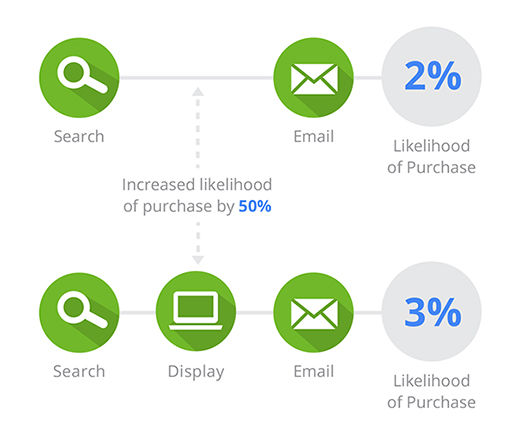When shopping online customers often touch multiple marketing channels before they convert. In marketing this is known as the consumer decision journey, a 4 step decision making funnel which looks like: Awareness -> Consideration -> Intent -> Loyalty.

In digital marketing this journey is referred to as a multi-channel funnel. These funnels are generated from conversion paths, the sequences of interactions (i.e., clicks/referrals from channels) that led up to each conversion and transaction. Google AdWords and Google Analytics have always had position and rule-based attribution models available (last click, first click, time decay and linear) but recently introduced a new model that uses a sophisticated algorithm that assigns partial conversion credit to your marketing touchpoints.
What is Data-Driven Attribution?
In 2013 Google unveiled the Data-Driven attribution model for Google Analytics Premium, and in 2014 they released it in AdWords. Unlike standard position or rule-based attribution models Data-Driven Attribution uses actual data from your Analytics account to generate a custom model for assigning conversion credit to marketing touchpoints throughout the entire customer journey. Data-Driven Attribution uses all available path data—including data from both converting and non-converting users—to understand how the presence of particular marketing touchpoints impacts your users’ probability of conversion. The resulting probability models show how likely a user is to convert at any particular point in the path, given a particular sequence of events.

How Does Google Algorithmically Assign Conversion Credit?
Data-Driven Attribution uses an algorithm based on a concept from cooperative game theory called the Shapley Value. The Shapley Value was developed by the economics Nobel Laureate Lloyd S. Shapley as an approach to fairly distributing the output of a team among the constituent team members. In the case of Data-Driven Attribution, the “team” being analyzed has marketing touchpoints (e.g., Organic Search, Display, and Email) as “team members,” and the “output” of the team is conversions. The Data-Driven Attribution algorithm computes the counterfactual gains of each marketing touchpoint—that is, it compares the conversion probability of similar users who were exposed to these touchpoints, to the probability when one of the touchpoints does not occur in the path.

How Do Cooperative Game Theory and the Shapley Value Work?
The actual calculation of conversion credit for each touchpoint depends on comparing all of the different permutations of touchpoints and normalizing across them. This means that the Data-Driven Attribution algorithm takes into account the order in which each touchpoint occurs and assigns different credit for different path positions. For example, Display preceding Paid Search is modeled separately than Paid Search preceding Display.
Example
In the following high-level example, the combination of Organic Search, Display, and Email leads to a 3% probability of conversion. When Display is removed, the probability drops to 2%. The observed 50% increase when Display is present serves as the basis for attribution.

What Data Is Used in Data-Driven Attribution?
In addition to data from organic search, direct, and referral traffic, Data-Driven Attribution analyzes data from all of the Google products that you’ve linked to Analytics, such as AdWords, the Google Display Network, and DoubleClick Campaign Manager. It also incorporates data that you import via the Cost Data Upload feature. Data-Driven Attribution leverages the conversion path data from Multi-Channel Funnels, as well as path data from users who don’t convert.
Can I Use Data-Driven Attribution?
Data-Driven attribution is only available in Google Analytics Premium and AdWords under certain conditions. In order for Data-Driven Attribution to generate a model for your selected conversion type, you must meet the minimum conversion threshold for the past 28 days. The current threshold is:
- 400 conversions per conversion type with a path length of 2+ interactions (i.e., 400 conversions for a specific goal or transaction, not a sum of 400 over all conversion types)
AND
- 10,000 paths in the selected reporting view (roughly equivalent to 10,000 users, although a single user may generate multiple paths)
What Should I Do If I Can’t Use Data-Driven Attribution?
There is no one size fits all solution to attribution modeling. Every business has different marketing needs and needs to figure how how to allocate their marketing dollars to drive the most performance. Instead of last click attribution, consider using time-decay or position based attribution models in Google Analytics. Additionally, GA offers a model comparison tool which lets you compare 3 models against each other and a custom model builder tool in the admin settings of each view.
Contact us today to get a free analytics consultation and we can work with you to figure our your conversion attribution strategy.






